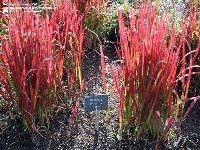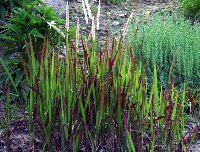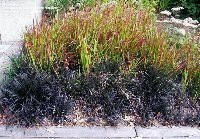





The grass is not always greener on the other side. Cogongrass is a good example of how non-native plants can take over the landscape, disrupt our fragile ecosystem and take years to eradicate. This is one more reason why we should plant native alternatives instead.
Imperata cylindrica, also known as cogongrass, is highly invasive in the Southeastern U.S. It spreads across the land at a rate exceeding that of the kudzu vine, Pueraria lobata. In fact, I. cylindrica has eclipsed the kudzu vine as the most obnoxious weed in the state of Florida.[1] It is listed as a federal noxious weed in the United States. If you think you have cogongrass on your property, please contact your state department of agriculture or USDA-APHIS office.
Dr. Shibu Jose is an associate professor of forest ecology in the School of Forest Resources and Conservation at the University of Florida. He has done extensive research for a decade into the growth habit, spread and management of this non-native invasive plant. In 2003, the estimated number of acres which contain or are covered by kudzu in the Southeast was 1 million while cogongrass covered 1.5 million acres. Florida alone was estimated to have about .5 million acres of the grass.[2]
 Wilson Faircloth, USDA Agr.
Wilson Faircloth, USDA Agr.
Research Serv., Bugwood.orgCogongrass first arrived in the U.S. by ship from Japan in Mobile, Alabama in 1912. At that time, it was being used as packing material. Much like the kudzu vine, cogongrass was then deliberately planted by well-meaning Americans. In the 1920s ranchers planted it with the hope that they had found a new forage crop for their cattle. Cattle ate the grass when it was very young but would not eat it once it was mature. This was thought to be due to the sharp edges on the leaves, caused by silica, once the plant matured.
The Department of Transportation in several states planted the grass along highways in an attempt to control erosion. Like the kudzu vine, this caused more harm than good.

Cogongrass tends to grow in thick circular patches. The leaves are yellow-green, three to four feet long and may reach six feet long although, this is not typical. Flower/seed heads are cylindrical and up to eight inches long with fluffy white seeds that can be easily carried on the breeze.
Managing Cogongrass
When treating cogongrass, you should make certain to cover entire plant with herbicide. You will need to spray plants as soon as they emerge and not wait for them to mature, if possible. If plants are treated during a drought, they will most likely survive the herbicide and need retreatment.
"Cogongrass in small (less than 20-foot diameter) patches can be treated with a glyphosate solution in early fall (August to October)." Retreatment may be necessary. For more information on treatment and mixing instructions see "Wanted Dead Not Alive: Cogongrass" published by Auburn University.
Dr. Jose states that using fire only seems to help the grass thrive in that it kills off other plants growing nearby, giving cogongrass more space to spread. Burning may be used in conjunction with other treatments to eradicate the grass. He also subscribes to a regimen of herbicide application, mowing, tilling, burning and re-introducing native plants to an area invaded by cogongrass.
 Japanese Blood Grass
Japanese Blood GrassLandscaping with Japanese Blood Grass
Several red-leaved forms of I. cylindrica have been cultivated for landscaping in the U.S. and is commonly known as Japanese blood grass. I. cylindrica 'Rubra' or ‘Red Baron' are still being sold and passed from gardener to gardener as one of the most common ornamental grasses planted in home gardens. Admittedly, it is a beautiful addition to the landscape; however, this plant can revert back to its green parentage.
In doing so, it may be considered part of the problem. This should be reason enough to search for other options for the home garden.  Japanese Blood Grass
Japanese Blood Grass
Photo courtesy of Dave's
Garden member, mgarr
There are many choices that rival Japanese blood grass. Why not try the North American native Schizachyrium scoparium, little bluestem, for its blue-green stems which turn a nice bronze-purple in the fall? This grass flowers in pairs followed by seeds that look like silvery-white feathers which mature in the fall. S. scoparium 'Blaze' matures later than little bluestem and has very vivid fall color.
Also a native, the very showy Muhlenbergia capillaris or Gulf muhlygrass, puts on a show to beat the band. It will fill an area with a lovely purple haze of feathery blooms that will have all the neighbors talking about your garden. The flowers appear in late summer and are replaced by seeds that are just as showy.
Another native is Sorghastrum nutans or indiangrass. This grass has graceful light green to blue leaves with yellow-gold blooms in summer followed by golden foliage in the fall.
There are many grasses that will fit perfectly in the home landscape. Doing a bit of research before you plant is always a good idea.
Happy Gardening
Top right photo used with permission, John D. Byrd, Mississippi State University, Bugwood.org
For more information:
[1] USDA
[2] UF/IFAS
Shibu Jose, Assistant Professor, School of Forest Resources and Conservation, University of Florida, 5988 Highway 90, Building 4900, Milton, FL, 32583
"Alien Plant Invasions: The Story of Cogongrass in Southeastern Forests" published by Society of American Foresters and co-authored by Dr. Shibu Jose is a good source of information on cogongrass.
Dr. Richard "Rick" Williams, Associate Professor, Extension Forestry Specialist, School of Forest Resources and Conservation, University of Florida, 5988 Highway 90, Building 4900, Milton, FL, 32583
(Editor's Note: This article was originally published on November 12, 2008. Your comments are welcome, but please be aware that authors of previously published articles may not be able to promptly respond to new questions or comments.)
Copyright © www.100flowers.win Botanic Garden All Rights Reserved